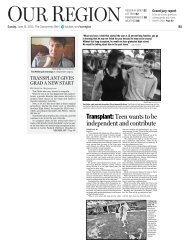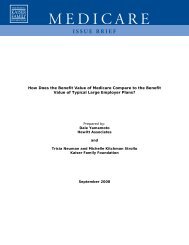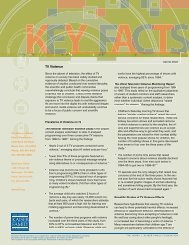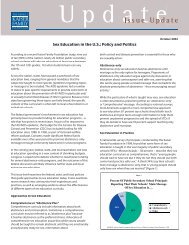HEALTH CARE COSTS: A PRimER - The Henry J. Kaiser Family ...
HEALTH CARE COSTS: A PRimER - The Henry J. Kaiser Family ...
HEALTH CARE COSTS: A PRimER - The Henry J. Kaiser Family ...
Create successful ePaper yourself
Turn your PDF publications into a flip-book with our unique Google optimized e-Paper software.
to make health care decisions more informed and collaborative within a delivery<br />
system that is often highly disaggregated and dependent on a multiple public and<br />
private payers with varying priorities and payment approaches. A partial answer to this<br />
challenge may come from some of the new payment approaches being implemented or<br />
demonstrated by Medicare under new authority contained in the ACA (see below). In<br />
the past, successful payment strategies adopted by Medicare (such as DRGs for<br />
hospital payments and the RBRVS for paying physicians) have been widely adopted by<br />
private payers and have become industry standards. Medicare is a substantial payer<br />
and is able to exert a significant influence on the delivery system. New attention in<br />
Medicare to more integrated and accountable approaches to delivery and payment<br />
may establish organizations and systems that can be more widely adopted and<br />
reinforced by other public and private payers.<br />
Over the longer run, the ability of the health care system to treat more conditions<br />
and deliver more care means that health care costs will grow faster than the<br />
economy as a whole. As incomes rise, societies generally spend more of their wealth<br />
on health care. Health care is a vital good and through research and innovation the<br />
health care system is able to provide new and better services and address previously<br />
untreatable conditions. Over the longer run, this continuing innovation increases<br />
health, but challenges societies to find ways to pay for the increasing costs. Bringing<br />
health spending growth closer to the rate of overall economic growth would likely<br />
require finding ways to slow the development, diffusion, and use of new health care<br />
technologies and practices. Doing so necessarily restrains spending that may improve<br />
health, so policy-makers need to be mindful of the difficult tradeoffs involved in such<br />
decisions.<br />
One approach that is widely used in other countries and is beginning to be<br />
implemented in the United States is that of developing approaches to explicitly assess<br />
and weigh the benefits and costs of new technologies, although such evaluations<br />
present serious challenges. 37 <strong>The</strong> sheer volume and pace of medical advances would<br />
make it difficult to assess important changes before they are incorporated into medical<br />
practice; focusing on the most expensive new treatment options might be more<br />
practical and could have a meaningful impact on cost growth. 38 Legislation in 2009<br />
and 2010 has provided federal funding for the development and dissemination of<br />
comparative effectiveness research. Health technology assessment may also involve<br />
difficult decisions about whether a medical benefit is worth the cost and whether it<br />
should be covered by a public or private insurance program. For example, the National<br />
Institute for Health and Clinical Excellence (NICE), the U.K. authority charged with<br />
approving medical treatments, received widespread criticism when it excluded beta<br />
interferon to treat multiple sclerosis from the list of publicly-covered treatments. 39<br />
Another way to slow technology and innovation growth is by increasing patient cost<br />
sharing. Higher cost sharing reduces demand (and, for people with few resources,<br />
may essentially prevent access to some services), which over the longer run will<br />
dampen incentives for research and investment. This approach is controversial for<br />
many reasons, in large part because it can raise cost barriers to even necessary and<br />
appropriate care. <strong>The</strong>re also may be limits to how high cost sharing can go before it is<br />
considered too punitive to be acceptable to employers and families purchasing<br />
coverage.<br />
28 THE HENRY J. KAISER FAMILY FOUNDATION












